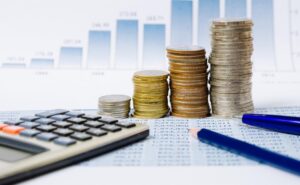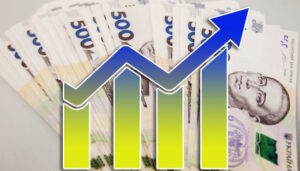
The macro forecast of the Ministry of Economy, which formed the basis of the draft state budget-2024, assumes a sharp improvement in the security situation from the second half of next year and, as one of the consequences, an acceleration of economic growth to 5% in 2024 and 7-7.5% in 2025-2026.
“Further economic development of Ukraine depends on the duration and active phase of military operations… Thanks to the military successes of Ukrainian defenders and protectors, a significant reduction of security risks is expected from the second half of 2024, which will positively affect the indicators of economic and social development of Ukraine for 2025-2026,” the document says.
According to the forecast, dated mid-June this year, inflation (at the end of the year) will fall to 10.8% next year, to 7% in 2025 and 5.8% in 2026.
Other estimates include unemployment falling from 18.8% this year to 10.8% in 2026.
In the formation of the revenue side is expected to increase revenues from the National Bank in 2025 to 103.9 billion UAH from 17.7 billion UAH in 2024 with a subsequent reduction to 15.4 billion UAH.
As reported, the government on Friday approved the draft state budget-2024 with revenues of UAH 1 trillion 746.3 billion, expenditures of UAH 3 trillion 108.2 billion and a marginal deficit of UAH 1 trillion 593.6 billion.
In relation to the current law on the state budget-2023, it is proposed to increase revenues by 25.6%, expenditures – by 7.6%, and reduce the deficit by 7.3%.
At the same time, this week the government submitted to the Rada a draft law No. 10038 with amendments to the state budget-2023 to increase its expenditures by 328.5 billion hryvnias due to the growth of internal loans by 207.6 billion hryvnias and external loans by 91.2 billion hryvnias.
Compared to it, revenues in the draft state budget-2024 are higher by 23.3%, or by 329.9 billion UAH, while expenditures are lower by 2.5%, or by 84 billion UAH, and the deficit – by 20.7%, or 416.8 billion UAH.
Experts Club Research Project and Maxim Urakin recently released an analytical video on the economy of Ukraine and the world
You can subscribe to the Experts Club YouTube channel by following the link – https://www.youtube.com/@ExpertsClub

The gross domestic product (GDP) of Ukraine after a decrease in the first quarter of 2023 by 10.5% against the first quarter of 2022 in the second and third quarters switched to growth, is indicated in the explanatory note to the government’s draft state budget for 2024.
“According to estimates of the Ministry of Economy, at the end of eight months, growth is 3%,” the document says.
According to it, “certain types of economic activities” managed to quickly adapt to the consequences of the destruction of the dam of the Kakhovskaya HPP.
“Better than expected results of economic activity are due to the rapid adaptation of enterprises to the new conditions of activity together with the recovery of domestic demand, which was the traditional driver of growth of the Ukrainian economy in previous years,” – noted in the explanatory note.
First Deputy Prime Minister and Minister of Economy Yulia Sviridenko announced last week that the forecast for GDP growth in 2023 had been raised to 4%, but the explanatory note still says that the economy will grow by 2.8% this year with inflation at 14.7%, although it fell to 8.6% in August.
According to the explanatory note, the Ministry of Economy as of mid-June this year predicted GDP growth next year by 5% with inflation falling to 10.8% at the end of the year.
The National Bank of Ukraine in late July raised its forecast for Ukraine’s GDP growth in 2023 from 2% to 2.9%, but lowered it for 2024 from 4.3% to 3.5%. In addition, the NBU improved its inflation estimate this year from 14.8% to 10.6%, and next year – to 8.5%.
Experts Club Research Project and Maxim Urakin recently released an analytical video about the economy of Ukraine and the world.
You can subscribe to the Experts Club YouTube channel by following the link – https://www.youtube.com/@ExpertsClub

Ukraine’s negative balance of foreign trade in goods in January-July 2023 tripled to $13.879 billion from $4.315 billion in the same period of 2022, the State Statistics Service (Gosstat) reported on Thursday.
According to its data, exports of goods from Ukraine for the period under review decreased by 14.7% to $21.795 billion compared to January-July 2022, while imports increased by 19.4% to $35.673 billion.
The State Statistics Service clarified that in July-2023, compared to June-2023, seasonally adjusted exports decreased by 11.7% to $2.671 billion, while imports increased by 1.7% to $5.132 billion.
The seasonally adjusted foreign trade balance in July 2023 was negative and amounted to $2.461 billion, while in the previous month it was also negative – $2.018 billion.
The State Statistics Service clarified that foreign trade operations were conducted with partners from 225 countries. The Experts Club research project and Maksym Urakin have recently released an analytical video about the economies of Ukraine and the world – https://youtu.be/zCJ1cU3n0sY?si=whY2sRqoznCjmcb7
You can subscribe to the Experts Club YouTube channel at https://www.youtube.com/@ExpertsClub

The Ministry of Economy has raised its forecast for Ukraine’s gross domestic product (GDP) growth in 2023 to 4%, First Deputy Prime Minister and Minister of Economy Yulia Svyrydenko said in Kyiv on Saturday at the annual meeting of the Yalta European Strategy organized by the Victor Pinchuk Foundation.
“This year, we believe that GDP growth will be 4%, although pessimists believe that 3%… We have maintained macro stability, this is the basis for further recovery of Ukraine,” she said.
Svyrydenko clarified to Interfax-Ukraine that the government has not yet approved the forecast for 2024, while the National Bank of Ukraine expects GDP growth of 3.5%, and up to 6.8% in 2025.
“We are always more optimistic than the National Bank,” the First Deputy Prime Minister and Minister of Economy said.
She added that inflation, according to the NBU’s forecast, will slow to 10.6% this year, and core inflation to 9%.
In her speech, the First Vice Prime Minister also reminded that the NBU had recently cut the discount rate to 22% per annum.
“As a participant in this discussion, I will say that I was in favor of a bigger reduction. I think that our macroeconomic situation allows us to be more flexible, but, as always, realistic,” Svyrydenko said.
According to her, the Ministry of Economy sees improvements in the agricultural sector and expects that in November a working instrument for military insurance will be created through the efforts of both the Ukrainian government and the European Bank for Reconstruction and Development (EBRD).
The First Deputy Prime Minister emphasized that the government is also actively working on a four-year development plan under the Ukraine Facility program announced by the EU, which will start operating in early 2024 and will become the basis for further growth of its economy.
As reported, in June, the Ministry of Economy slightly downgraded its GDP forecast for this year from 3.2% to 2.8% due to the destruction of the Kakhovka hydroelectric power plant and pessimistic expectations for the upcoming harvest. According to Natalia Gorshkova, Director of the Strategic Planning and Macroeconomic Forecasting Department of the Ministry of Economy, in early August, the Ministry had already assumed economic growth of 5% in 2023, but so far it has conservatively maintained the 2.8% estimate, taking into account the existing risks. At that time, the Ministry of Economy predicted that GDP growth would accelerate to 5% next year, with inflation slowing to 10.8%.
At the end of July, the National Bank of Ukraine raised its forecast for Ukraine’s GDP growth in 2023 from 2% to 2.9%, but lowered it for 2024 from 4.3% to 3.5%. In addition, the NBU improved its inflation estimate this year from 14.8% to 10.6%, and next year to 8.5%.
In August, inflation in Ukraine fell to 8.6% in annual terms.
The Experts Club research project and Maksym Urakin recently released an analytical video about the economies of Ukraine and the world – https://youtu.be/zCJ1cU3n0sY?si=LFj-pDmojahwtHkA
You can subscribe to the Experts Club YouTube channel at https://www.youtube.com/@ExpertsClub

Africa’s population growth rate threatens that the continent’s resources will no longer be enough to meet the needs of its inhabitants, Egyptian President Abdel Fattah al-Sisi said on Tuesday.
“On the African continent, we will reach the 1.6 billion mark within a few years. Africa is abundant with resources, but they cannot help everyone,” Arab news quoted the president as saying at the first Global Congress on Population, Health and Development, which runs from September 5 to 8 in Cairo.
He noted that the congress should be held annually due to the urgency of the problem.
According to the president, the number of Egyptian citizens reaches 105 million, and in addition to them, there are another 9 million people in the country, but the Egyptian government, unlike some other countries, manages to cope with the related challenges. At the same time, al-Sisi clarified, the ratio between national resources and population growth has become less optimal over the past 75 years, and this has affected the health and education system.
For his part, Egyptian Health Minister Khalid Abdel Ghaffar emphasized that demographic growth is the most serious challenge for the country. Minister of Planning and Economic Development Hala El-Sayed noted that although the birth rate has declined, Egypt’s population has grown by another 25 million people over the past 10 years.
Earlier, the Experts Club project released an analytical video about economic relations between Egypt and Ukraine.
You can subscribe to the Experts Club YouTube channel by following the link – https://www.youtube.com/@ExpertsClub

Stably high interest rates in the world’s largest economies mean that global economic growth is likely to slow in 2024 after this year’s rate of recovery exceeded expectations, the Financial Times writes, citing the opinion of economists.
Thus, according to the forecast of the consulting company Consensus Economics, in 2024 GDP will grow by 2.1% compared to 2.4% expected in the economy this year. Meanwhile, the estimate for 2023 was raised from the 1.4% assumed at the beginning of the year due to unexpectedly strong consumer demand and labor market.
Capital Economics senior global economist Simon Macadam also believes that the expected slowdown in economic growth next year will be partly due to a more substantial rebound in 2023. However, he added that economists “have actually become more pessimistic about the outlook for 2024”.
This is due to beliefs that persistently strong demand will keep inflation higher for longer, pushing advanced economy Central Banks to keep rates high throughout the year.
“Demand is barely weakening, the labor market remains strong, and wages continue to rise,” notes Citi Chief Economist Nathan Sheets. – Some of the weakening in the economy (which was expected this year – IF-U) is being carried over to 2024.” In many countries, including the U.S., “there will be a recession, it will just come later,” he predicts.
Until a few months ago, the Federal Reserve was expected to start cutting rates this year. But the resilience of the U.S. economy indicates there is a small possibility that the Fed could raise borrowing costs by another quarter-point in September, to 5.5-5.75% per annum. And economists now expect the first rate cut to occur next spring.
The high probability that the U.S. economy will avoid recession this year “means the Fed will hold rates higher longer to fully suppress inflation, leading to slower growth in 2024,” according to Mark Zandi, chief economist at Moody’s Analytics.
On average, economists forecast the U.S. economy to rebound 0.6% in 2024 after expanding 1.9% at the end of this year.
Europe’s economies have also performed “somewhat better than expected” this year, with the exception of Germany, meaning the European Central Bank and the Bank of England are also likely to keep rates on hold for longer, Zandi said.
The ECB raised its deposit rate from minus 0.5% per annum in June 2022 to the current 3.75% and is not expected to cut it for most of next year. The Bank of England is forecast to increase its cost of borrowing by a further half a percent to 5.75% by the end of this year and is unlikely to start cutting it until the second half of 2024.
Christian Keller, head of economic research at Barclays, notes that the negative investor sentiment towards 2024 is also due to a slowdown in China’s GDP growth after a significant acceleration following the removal of anti-Kowitz restrictions.
Experts Club Research Project and Maxim Urakin recently released an analytical video on the Ukrainian and global economies
You can subscribe to the Experts Club YouTube channel at https://www.youtube.com/@ExpertsClub